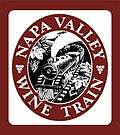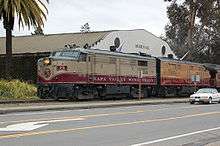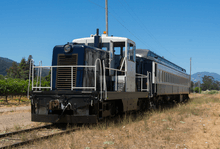Napa Valley Wine Train
| Napa Valley Wine Train | ||||||||||||||||||||||||||||||||||||||||||||||||||||||||||||||||||||||||||||||||||||||||||
|---|---|---|---|---|---|---|---|---|---|---|---|---|---|---|---|---|---|---|---|---|---|---|---|---|---|---|---|---|---|---|---|---|---|---|---|---|---|---|---|---|---|---|---|---|---|---|---|---|---|---|---|---|---|---|---|---|---|---|---|---|---|---|---|---|---|---|---|---|---|---|---|---|---|---|---|---|---|---|---|---|---|---|---|---|---|---|---|---|---|---|
 | ||||||||||||||||||||||||||||||||||||||||||||||||||||||||||||||||||||||||||||||||||||||||||
.jpg) | ||||||||||||||||||||||||||||||||||||||||||||||||||||||||||||||||||||||||||||||||||||||||||
| Locale | Napa County, California, USA | |||||||||||||||||||||||||||||||||||||||||||||||||||||||||||||||||||||||||||||||||||||||||
| Connections |
Union Pacific Railroad and California Northern Railroad | |||||||||||||||||||||||||||||||||||||||||||||||||||||||||||||||||||||||||||||||||||||||||
| Commercial operations | ||||||||||||||||||||||||||||||||||||||||||||||||||||||||||||||||||||||||||||||||||||||||||
| Original gauge | 4 ft 8 1⁄2 in (1,435 mm) standard gauge | |||||||||||||||||||||||||||||||||||||||||||||||||||||||||||||||||||||||||||||||||||||||||
| Preserved operations | ||||||||||||||||||||||||||||||||||||||||||||||||||||||||||||||||||||||||||||||||||||||||||
| Operated by | Napa Valley Railroad | |||||||||||||||||||||||||||||||||||||||||||||||||||||||||||||||||||||||||||||||||||||||||
| Reporting mark | NVRR | |||||||||||||||||||||||||||||||||||||||||||||||||||||||||||||||||||||||||||||||||||||||||
| Stations | 4 | |||||||||||||||||||||||||||||||||||||||||||||||||||||||||||||||||||||||||||||||||||||||||
| Length | 18.0 mi (29.0 km) | |||||||||||||||||||||||||||||||||||||||||||||||||||||||||||||||||||||||||||||||||||||||||
| Preserved gauge | 4 ft 8 1⁄2 in (1,435 mm) standard gauge | |||||||||||||||||||||||||||||||||||||||||||||||||||||||||||||||||||||||||||||||||||||||||
| Commercial history | ||||||||||||||||||||||||||||||||||||||||||||||||||||||||||||||||||||||||||||||||||||||||||
| 1864 | Started | |||||||||||||||||||||||||||||||||||||||||||||||||||||||||||||||||||||||||||||||||||||||||
| 1869 | Purchased by California Pacific Railroad Extension Company and becomes California Pacific Railroad | |||||||||||||||||||||||||||||||||||||||||||||||||||||||||||||||||||||||||||||||||||||||||
| 1895 | leased to Southern Pacific Railroad | |||||||||||||||||||||||||||||||||||||||||||||||||||||||||||||||||||||||||||||||||||||||||
| 1898 | Southern Pacific Railroad takes over | |||||||||||||||||||||||||||||||||||||||||||||||||||||||||||||||||||||||||||||||||||||||||
| 1905 |
Electrification and renamed San Francisco, Napa and Calistoga Railway | |||||||||||||||||||||||||||||||||||||||||||||||||||||||||||||||||||||||||||||||||||||||||
| 1985 | Southern Pacific Railroad notified the ICC of its intent to abandon | |||||||||||||||||||||||||||||||||||||||||||||||||||||||||||||||||||||||||||||||||||||||||
| 1987 | Freight service ceased | |||||||||||||||||||||||||||||||||||||||||||||||||||||||||||||||||||||||||||||||||||||||||
| Closed to passengers | 1929 | |||||||||||||||||||||||||||||||||||||||||||||||||||||||||||||||||||||||||||||||||||||||||
| Closed | 1987 | |||||||||||||||||||||||||||||||||||||||||||||||||||||||||||||||||||||||||||||||||||||||||
| Preservation history | ||||||||||||||||||||||||||||||||||||||||||||||||||||||||||||||||||||||||||||||||||||||||||
| 1987 | NVRR established | |||||||||||||||||||||||||||||||||||||||||||||||||||||||||||||||||||||||||||||||||||||||||
| 1987 | NVRR acquires right-of-way | |||||||||||||||||||||||||||||||||||||||||||||||||||||||||||||||||||||||||||||||||||||||||
| 1989 | Began operation | |||||||||||||||||||||||||||||||||||||||||||||||||||||||||||||||||||||||||||||||||||||||||
| Headquarters | Napa, California | |||||||||||||||||||||||||||||||||||||||||||||||||||||||||||||||||||||||||||||||||||||||||
| Website | ||||||||||||||||||||||||||||||||||||||||||||||||||||||||||||||||||||||||||||||||||||||||||
| http://www.winetrain.com | ||||||||||||||||||||||||||||||||||||||||||||||||||||||||||||||||||||||||||||||||||||||||||
| ||||||||||||||||||||||||||||||||||||||||||||||||||||||||||||||||||||||||||||||||||||||||||
The Napa Valley Wine Train[1] is operated by the Napa Valley Railroad (reporting mark NVRR). The train is a privately operated excursion train that runs between Napa and St. Helena, California. Much of the rail line parallels State Route 29 after leaving the City of Napa and passes the towns of Yountville, Rutherford and Oakville. The route passes by many the region's vineyards and wineries located in Napa County.
History
Early years
The railroad's track is part of what was originally the Napa Valley Railroad founded by early California pioneer Samuel Brannan in 1864. Brannan established it to bring tourists to the resort town of Calistoga, California which he also founded. The railroad's 42 miles (68 km) of track ran from Calistoga to Vallejo, California where it connected with San Francisco Bay Area ferry boat service. California Pacific Railroad Extension Company purchased the Napa Valley Railroad Company at a foreclosure sale on June 9, 1869. Later that same year on December 23, the railroad was renamed the California Pacific Railroad. The track was leased to Southern Pacific Railroad on April 1, 1885 and was soon connected to their main line in Suisun, California. California Pacific Railroad was acquired by Southern Pacific on April 14, 1898. The line was extended to Benicia, California in 1904. The electric interurban railroad San Francisco, Napa and Calistoga Railway was built parallel to the NVRR and opened in 1905 until the 1930s. The NVRR track was utilized by Southern Pacific as a freight branch line for the following 58 years until 1987 when the railroad petitioned for abandonment.
Birth of a new railroad
The NVRR operating company was formed in 1987 by local entrepreneurs and headed by Vincent DeDomenico. DeDomenico was a veteran of more than 50 years in the food business and was formerly the president of Golden Grain, a company founded by his father and famous for its Rice-A-Roni. DeDomnico purchased the Ghirardelli Chocolate Company in 1964 and sold both it and Golden Grain to the Quaker Oats Company in 1986. The NVRR acquired the right of way for $2.5 Million after Southern Pacific notified the Interstate Commerce Commission of its intent to abandon the line in 1985.
The new company's plans to create a tourist-oriented Wine Train were strongly opposed by local community activists and several city governments. Some people disliked the noise and pollution of an active passenger train line in their midst, while others felt that the train would attract even more visitors to the Napa Valley, which they saw as already over-saturated with tourists. The project's opponents persuaded the state Public Utilities Commission (PUC) to order the company to comply with the rigorous requirements of the California Environmental Quality Act (CEQA). However, in a 4-3 decision handed down on March 19, 1990, the Supreme Court of California [2] held that the PUC had no jurisdiction to require CEQA certification because the train fell under the CEQA exemption for "the institution or increase of passenger or commuter service on rail lines already in use."[3]
The gap in actual usage during the prolonged transition from Southern Pacific freight use to the proposed Wine Train service was not enough to take the line out of use, although the many years of deferred maintenance necessitated the investment of approximately $20 Million to rehabilitate the line before trains could be safely operated on it. The rail line connects to the Union Pacific Railroad and California Northern Railroad and has hosted special trains from Amtrak as well as private excursion trains.[4]
Operations
The Napa Valley Wine Train has been in operation since September 16, 1989, and has now carried more than two million passengers. This train has a capacity of 370 passengers and typically makes two runs a day. The train is normally pulled by two of the four late-1950s era Alco FPA-4 engines in the company's inventory. These engines were originally built by Montreal Locomotive Works and first owned by Canadian National Railway and later by Via Rail. Two of the engines were modified by the railroad to run cleaner on a combination of natural gas and diesel fuel. One was dual fuel (NVR 70), and the other was 100% CNG (Compressed Natural Gas) (NVR 73). Presently, #70 has been converted back to 100% diesel, while the #73 remains 100% CNG.
NVRR currently runs nine cars on its passenger train consisting of lounge, observation and dining cars originally built by the Pullman Company in the early-1900s for the Northern Pacific Railroad. These cars were later sold to Denver and Rio Grande Western Railroad in 1960 and used for the Ski Train between Denver, Colorado and Winter Park, Colorado before the NVRR purchased them in 1987. The cars were extensively refurbished and modified by NVRR before the railroad placed them back into service. Modifications included adding air conditioning and 4 inches of concrete to the car floors in order to stabilize the ride due to the train's low speed. The interiors were remodeled using Honduran mahogany and plush fabrics. The railroad added a Super Dome car to its fleet in 1997. This car was originally built in 1952 for the Chicago, Milwaukee, St. Paul and Pacific Railroad and had logged more than a million miles for that railroad prior to being acquired by the NVRR. After the railroad bought this car, the exterior was rebuilt by the Ringling Bros. and Barnum & Bailey Circus train repair yard in Palmetto, Florida while the interior was restored, updated, and customized by NVRR. A modified box car containing a 450KW generator was added to the consist in 2013 in order to maintain constant power to the train during the time that the locomotives are switched for the return trip from St. Helena. During the modification process, the roof of this car was lowered by two feet in order to preserve the view from the dome car and weight was added to the side of the car opposite from the generator in order to balance the load.[5]
During the 3-hour-long, 36-mile (58 km) round-trip between Napa and St. Helena, passengers can choose to enjoy a gourmet meal prepared on board. They can also sample several of the region's wines available at the wine bar located in one of the lounge cars. The train offers optional stops for tours of Domaine Chandon Winery in Yountville, Grgich Hills Estate in Rutherford, and a motor coach tour of Raymond Winery in St. Helena and ZD Winery in Napa for an additional fee. The train hosts several special events throughout the year including murder mystery dinner theater, vintner's luncheons, appellation dinners and holiday excursions.
In June 2009, the St. Helena City Council voted to allow the Wine Train passengers to disembark in St. Helena on a trial basis on the first Friday of the month (May–October). [6] Following the death of Vincent DeDomenico in October 2007, [7] [8] DeDomenico family members chose son-in-law Gregory McManus to step into the position of CEO.[9]
In December 2009, United States Senators John McCain and Tom Coburn criticized a $54 million appropriation for replacing two existing railroad trestle bridges used by the wine train over the Napa River with higher ones. The money in the appropriation was for work on the Napa River Flood Project and part of the American Recovery and Reinvestment Act of 2009. Replacement of these bridges is part of the project's original plan. The $85 million contract for the work was awarded to the Alaska native corporation Suulutaaq Inc. McCain and Coburn included the appropriation on a list of 100 “wasteful or silly" projects in their 2009 “Stimulus Checkup” report. An official spokesman for the City of Napa along with several elected officials accused McCain and Coburn of political grandstanding for including the funding in their report.[10]
2015 controversy
On August 22, 2015, an 11-member book club group was removed from the train for lauging too loudly. The book club, Sisters on the Reading Edge, consisted of ten African-American women and one white woman, their ages ranging from 39 to 85.[11][12] A reporter on the train expressed dismay that they were removed,[13] and book club members described the experience as "humiliating."[14]
A post from Napa Valley Wine Train on their Facebook page accused the group of "physical and verbal abuse towards other guests and staff."[15] The post was subsequently removed.[16] Two days later, Napa Valley Wine Train hired crisis communications expert Sam Singer to apologize for both the incident and the Facebook post which he described as "incorrect." [17][18]
After the story was picked up by the local and national press, the Twitter hashtag #laughingwhileblack was used to express concern about racial bias, white privilege, and the actions of the wine train staff.[19] Fallout from the incident caused two book club members to lose their jobs. The book club filed a lawsuit seeking $11 million in damages, and after private mediation, reached a settlement in April 2016 for an undisclosed sum.[11]
Post-controversy operations
In September 2015 an announcement was made that the DeDomenico family had sold the railroad to Seattle-based Noble House Hotels & Resorts, Ltd. and Brooks Street, a California-based real estate development and investment company. [20]
In May 2016 Wine Train representatives announced a new service that will drop off and pick up passengers at four wineries along the railroad's route. The service called Quattro Vino is scheduled to debut on June 1, 2016. The new six hour tour will stop at Robert Mondavi, Charles Krug, Merryvale and V. Sattui wineries. Two new early 20th century Pullman passenger cars will be added to the railroad's existing fleet for the once per day tours. [21]
Locomotives


| Name | Builder / Model | Date | Builder Number | Notes |
|---|---|---|---|---|
| Locomotive #52 | GE /65-ton switcher | July 1943 | 17871 | |
| Locomotive #62 | Alco ALCO RS-11 | 1959 | 83416[22] | Bought from California Western Railroad-1989 |
| Locomotive #69 | EMD Rebuilt EMD GP9R | October 1958 | [23] | Formerly Portland and Western 1804. Entered into revenue service on November 2nd. 2016 |
| Locomotive #70 | Alco MLW/FPA-4 | October 1958 | 82269 | |
| Locomotive #71 | Alco MLW/FPA-4 | February 1959 | 83153 | |
| Locomotive #72 | Alco MLW/FPA-4 | April 1959 | 83165 | |
| Locomotive #73 | Alco MLW/FPA-4 | April 1959 | 83168 | Rebuilt to burn natural gas & [24] has a EMD 12-645E prime mover. |
Plans
The NVRR track is currently utilized for limited daily scheduled passenger excursions of the Napa Valley Wine Train and occasional freight service. A July 2003 study [26] examined the feasibility of acquiring right of way between St. Helena and Calistoga and adding commuter service on the route. This study included consideration for connecting with other mass transit services beyond the Napa Valley and increasing freight service.
Developers of the proposed 3200 unit townhome Napa Pipe project have proposed a private venture shuttle service that would utilize a portion of the NVRR line from the southern terminus of the line north to Redwood Road and Trancas Street.The proposed shuttle would continue south on Union Pacific Railroad owned right of way to American Canyon with trains leaving every 20 or 30 minutes. The developers have held preliminary discussions with NVRR as well as Union Pacific. [27] [28] Backers of the proposal to add commuter service released a business plan in early 2012 revealing that the service would need to carry 1 to 1.5 million passengers per year in order to achieve a profit.[29] Members of the Napa County Transportation and Planning Agency have expressed some initial interest in the proposal. [30]
See also
- List of California railroads
- List of heritage railroads in the United States
- List of heritage railways
- List of San Francisco Bay Area trains
References
- ↑ http://www.winecountrytourshuttle.com/napa_valley_wine_tours.htm
- ↑ Supreme Court of California opinion from California Continuing Education of the Bar
- ↑ "'Napa Valley Wine Train, Inc. v. Public Utilities Commission, 50 Cal. 3d 370 (1990)". Jusita US Law. Retrieved 13 July 2017.
- ↑ Doyle, Jim. "Chugging along / After 13 years, Napa Valley Wine Train rolls to a profit". SFGate. Hearst Communications Inc. Retrieved 13 July 2017.
- ↑ Huffman, Jennifer (2013-08-18). "No huffing and puffing at Wine Train". Napa Valley Register. Retrieved 2013-11-11.
- ↑ Duarte, Jesse (June 12, 2009). "Wine Train to stop in St. Helena". Napa Valley Register. Napa, CA: Lee Enterprises, Inc. Retrieved June 12, 2009.
- ↑ Kilusk, Bill (October 19, 2007). "Wine Train founder DeDomenico dies at 92". Napa Valley Register. Napa, CA: Lee Enterprises, Inc. Retrieved June 12, 2009.
- ↑ Guthrie, Julian (October 22, 2007). "Vincent DeDomenico dies - invented Rice-A-Roni, built wine train". San Francisco Chronicle. Napa, CA. Retrieved October 22, 2007.
- ↑ Courtney, Kevin (March 30, 2008). "Staying on Track". Napa Valley Register. Napa, CA: Lee Enterprises, Inc. Retrieved June 10, 2008.
- ↑ Jones, Jillian (December 11, 2009). "McCain hammers Napa flood control contract". Napa Valley Register. Napa, CA: Lee Enterprises, Inc. Retrieved October 17, 2010.
- 1 2 http://www.mercurynews.com/2016/04/18/east-bay-book-club-members-kicked-off-napa-wine-train-settle-lawsuit/
- ↑ Jr., Stephen A. Crockett. "11 Black Women Kicked Off Napa Wine Train for Laughing While Black". Retrieved 2015-08-25.
- ↑ "Another View: Let laughter roll down like wine | Auburn Journal". www.auburnjournal.com. Retrieved 2015-08-25.
- ↑ UTC, Marcus Gilmer2015-08-25 03:00:56. "Book group protests ejection from Napa wine train for being 'too loud'". Mashable. Retrieved 2015-08-25.
- ↑ "Book club group kicked off Napa Valley Wine Train". Retrieved 2015-08-25.
- ↑ "Booted book club shrugs off Napa Wine Train’s apology". Retrieved 2015-08-25.
- ↑ "Removal of black women from Napa Valley Wine Train sparks outrage". Retrieved 2015-08-25.
- ↑ "Black women's book club ordered off California tourist train | Al Jazeera America". Retrieved 2015-08-25.
- ↑ https://www.washingtonpost.com/lifestyle/style/lonnae-oneal-laughing-while-black-not-on-the-wine-train/2015/08/26/93dd9718-4bf2-11e5-902f-39e9219e574b_story.html
- ↑ Huffman, Jennifer (2015-09-15). "Update: Napa Valley Wine Train sold". Napa Valley Register. Retrieved 2015-09-19.
- ↑ Huffman, Jennifer (2016-05-11). "Wine Train plans new train, winery stops". St. Helena Star. Retrieved 2016-05-15.
- ↑ "NVRR - NAPA Valley Railroad Company Locomotive Roster - Railroad Picture Archives.NET".
- ↑ "NVRR - NAPA Valley Railroad Company Locomotive Roster - Railroad Picture Archives.NET".
- ↑ "NAPA VALLEY WINE TRAIN". Retrieved 2010-05-03.
- ↑ Edward Lewis Short Line Railway Guide (page 212)
- ↑ Napa/Solano Passenger/Freight Rail Study funded jointly by the Metropolitan Transportation Commission, Napa County Transportation Planning Agency and Solano Transportation Authority
- ↑ Jones, Jillian (September 17, 2008). "Rail system for Napa?". Napa Valley Register. Napa, CA: Lee Enterprises, Inc. Retrieved September 21, 2008.
- ↑ Noonan, James (September 13, 2011). "Investors hope to bring light rail to Napa". Napa Valley Register. Napa, CA: Lee Enterprises, Inc. Retrieved September 13, 2011.
- ↑ Jensen, Peter (January 11, 2012). "Napa Valley rail system would need a million riders". Napa Valley Register. Napa, CA: Lee Enterprises, Inc. Retrieved January 20, 2012.
- ↑ Jensen, Peter (January 20, 2012). "Transit agency cautious about supporting rail plan". Napa Valley Register. Napa, CA: Lee Enterprises, Inc. Retrieved January 20, 2012.
External links
| Wikimedia Commons has media related to Napa Valley Wine Train. |
- Napa Valley Wine Train official website
- Napa Valley Railroad Police Department
- The Antidote to Amtrak: The Napa Valley Wine Train
- Article about the early years of Napa railroad history
- Napa Valley wine route
Coordinates: 38°18′08″N 122°17′02″W / 38.302196°N 122.283797°W
